Macroalgal–Coral Interactions in New Caledonia South West Lagoon: Diversity, Abundance, and Spatial Patterns
Abstract
Simple Summary
Abstract
1. Introduction
2. Materials and Methods
2.1. Survey Area
2.2. Data Collection
2.2.1. Preliminary Qualitative Survey
2.2.2. Quantitative Survey
2.3. Typology of Macroalgal–Coral Associations
2.4. MCI Inventory and Abundance Assessment
2.5. Interaction Index Calculation
2.6. Estimation of MCI Richness
2.7. Spatial Patterns of MCI
3. Results
3.1. Typology of Macroalgal–Coral Associations
3.2. MCI Diversity
3.3. MCI Abundance and Patterns
3.4. Spatial Patterns of MCI
3.5. Algal Interaction Index vs. Abundance
4. Discussion
4.1. Diversity, Richness, and Abundance of Macroalgal–Coral Interactions
4.2. Specificity and Spatial Patterns of Interactions
4.3. Typologies of Associations and Coralgal Biotic Interaction Compass (CBIC)
4.4. The Role of Coral Architecture and Genus-Specific Traits
4.5. Human Influence and MCI
4.6. MCI Spatial Patterns: Signals of Long-Term Coevolution in Coral–Macroalgal–Herbivore Assemblages
5. Conclusions
Supplementary Materials
Author Contributions
Funding
Institutional Review Board Statement
Informed Consent Statement
Data Availability Statement
Acknowledgments
Conflicts of Interest
Abbreviations
| MCI | Macroalgal–coral interaction |
| SWLNC | Southwest lagoon of New Caledonia |
References
- Done, T.T.; Ogden, J.J.; Wiebe, W.; Rosen, B. Biodiversity and ecosystem function of coral reefs. In Functional Roles of Biodiversity: A Global Perspective; Mooney, H.A., Cushman, J.H., Medina, E., Sala, O.E., Schulze, E.D., Eds.; Wiley: Hoboken, NJ, USA, 1996; pp. 393–429. [Google Scholar]
- Vieira, C.; Payri, C.; De Clerck, O. A fresh look at macroalgal-coral interactions: Are macroalgae a threat to corals? Perspect. Phycol. 2016, 3, 129–140. [Google Scholar] [CrossRef]
- Fong, P.; Paul, V.J. Coral reef algae. In Coral Reefs: An Ecosystem in Transition; Dubinsky, Z., Stambler, N., Eds.; Springer Netherlands: Dordrecht, The Netherlands, 2011; pp. 241–272. [Google Scholar]
- Morrissey, J. Primary productivity of coral reef bsenthic macroalgae. In Proceedings of the 5th International Coral Reef Congress, Tahiti, France, 27 May–1 June 1985; p. 82. [Google Scholar]
- Tano, S.A.; Eggertsen, M.; Wikström, S.A.; Berkström, C.; Buriyo, A.; Halling, C. Tropical seaweed beds as important habitats for juvenile fish. Mar. Freshw. Res. 2017, 68, 1921–1934. [Google Scholar] [CrossRef]
- Stamski, R.E.; Field, M.E. Characterization of sediment trapped by macroalgae on a Hawaiian reef flat. Estuar. Coast. Shelf Sci. 2006, 66, 211–216. [Google Scholar] [CrossRef]
- Evans, R.; Wilson, S.; Field, S.; Moore, J. Importance of macroalgal fields as coral reef fish nursery habitat in north-west Australia. Mar. Biol. 2014, 161, 599–607. [Google Scholar] [CrossRef]
- Puk, L.D.; Ferse, S.C.; Wild, C. Patterns and trends in coral reef macroalgae browsing: A review of browsing herbivorous fishes of the Indo-Pacific. Rev. Fish Biol. Fish. 2016, 26, 53–70. [Google Scholar] [CrossRef]
- Verges, A.; Bennett, S.; Bellwood, D.R. Diversity among macroalgae-consuming fishes on coral reefs: A transcontinental comparison. PLoS ONE 2012, 7, e45543. [Google Scholar] [CrossRef]
- Côté, I.; Gill, J.; Gardner, T.; Watkinson, A. Measuring coral reef decline through meta-analyses. Philos. Trans. R. Soc. B Biol. Sci. 2005, 360, 385–395. [Google Scholar] [CrossRef] [PubMed]
- Schutte, V.G.; Selig, E.R.; Bruno, J.F. Regional spatio-temporal trends in Caribbean coral reef benthic communities. Mar. Ecol. Prog. Ser. 2010, 402, 115–122. [Google Scholar] [CrossRef]
- Hay, M.E. Herbivory, algal distribution, and the maintenance of between-habitat diversity on a tropical fringing reef. Am. Nat. 1981, 118, 520–540. [Google Scholar] [CrossRef]
- McCook, L.; Jompa, J.; Diaz-Pulido, G. Competition between corals and algae on coral reefs: A review of evidence and mechanisms. Coral Reefs 2001, 19, 400–417. [Google Scholar] [CrossRef]
- Folke, C.; Carpenter, S.; Walker, B.; Scheffer, M.; Elmqvist, T.; Gunderson, L.; Holling, C. Regime shifts, resilience, and biodiversity in ecosystem management. Annu. Rev. Ecol. Evol. Syst. 2004, 35, 557–581. [Google Scholar] [CrossRef]
- Rasher, D.B.; Hay, M.E. Seaweed allelopathy degrades the resilience and function of coral reefs. Commun. Integr. Biol. 2010, 3, 564–566. [Google Scholar] [CrossRef] [PubMed]
- Vroom, P.S.; Braun, C.L. Benthic composition of a healthy subtropical reef: Baseline species-level cover, with an emphasis on algae, in the Northwestern Hawaiian Islands. PLoS ONE 2010, 5, e9733. [Google Scholar] [CrossRef]
- Vroom, P.S.; Musburger, C.A.; Cooper, S.W.; Maragos, J.E.; Page-Albins, K.N.; Timmers, M.A. Marine biological community baselines in unimpacted tropical ecosystems: Spatial and temporal analysis of reefs at Howland and Baker Islands. Biodivers. Conserv. 2010, 19, 797–812. [Google Scholar] [CrossRef]
- Jackson, J.; Donovan, M.; Cramer, K.; Lam, V. Status and Trends of Caribbean Coral Reefs: 1970–2012; Global Coral Reef Monitoring Network: Washington, DC, USA, 2014; p. 304. [Google Scholar]
- Edwards, C.B.; Friedlander, A.M.; Green, A.; Hardt, M.; Sala, E.; Sweatman, H.; Williams, I.D.; Zgliczynski, B.; Sandin, S.A.; Smith, J.E. Global assessment of the status of coral reef herbivorous fishes: Evidence for fishing effects. Proc. R. Soc. B Biol. Sci. 2014, 281, 20131835. [Google Scholar] [CrossRef]
- Wu, P.; Wang, T.; Liu, Y.; Li, C.; Xiao, Y.; Xu, S.; Han, T.; Lin, L.; Quan, Q. Differences of macroalgal consumption by eight herbivorous coral reef fishes from the Xisha Islands, China. Front. Mar. Sci. 2022, 9, 882196. [Google Scholar] [CrossRef]
- Fabricius, K.E.; Crossman, K.; Jonker, M.; Mongin, M.; Thompson, A. Macroalgal cover on coral reefs: Spatial and environmental predictors, and decadal trends in the Great Barrier Reef. PLoS ONE 2023, 18, e0279699. [Google Scholar] [CrossRef]
- Morrow, K.M.; Ritson-Williams, R.; Ross, C.; Liles, M.R.; Paul, V.J. Macroalgal extracts induce bacterial assemblage shifts and sublethal tissue stress in Caribbean corals. PLoS ONE 2012, 7, e44859. [Google Scholar] [CrossRef]
- United States Environmental Protection Agency (EPA). U.S. Coral Reefs. Available online: https://www.epa.gov/coral-reefs/us-coral-reefs (accessed on 20 June 2025).
- Bruno, J.F.; Precht, W.F.; Vroom, P.S.; Aronson, R.B. Coral reef baselines: How much macroalgae is natural? Mar. Pollut. Bull. 2014, 80, 24–29. [Google Scholar] [CrossRef]
- Bennett, S.; Vergés, A.; Bellwood, D. Branching coral as a macroalgal refuge in a marginal coral reef system. Coral Reefs 2010, 29, 471–480. [Google Scholar] [CrossRef]
- Steinberg, P.D.; De Nys, R. Chemical mediation of colonization of seaweed surfaces. J. Phycol. 2002, 38, 621–629. [Google Scholar] [CrossRef]
- Vieira, C. Lobophora–coral interactions and phase shifts: Summary of current knowledge and future directions. Aquat. Ecol. 2020, 54, 1–20. [Google Scholar] [CrossRef]
- De Carvalho, L.L.; Villaca, R.C. Effect of fine-scale habitat differences on algal colonisation in a coral-dominated subtropical reef. An. Acad. Bras. Ciências 2021, 93, e20191191. [Google Scholar] [CrossRef] [PubMed]
- Birrell, C.L.; McCook, L.J.; Willis, B.L.; Harrington, L. Chemical effects of macroalgae on larval settlement of the broadcast spawning coral Acropora millepora. Mar. Ecol. Prog. Ser. 2008, 362, 129–137. [Google Scholar] [CrossRef]
- Paul, V.J.; Kuffner, I.B.; Walters, L.J.; Ritson-Williams, R.; Beach, K.S.; Becerro, M.A. Chemically mediated interactions between macroalgae Dictyota spp. and multiple life-history stages of the coral Porites astreoides. Mar. Ecol. Prog. Ser. 2011, 426, 161–170. [Google Scholar] [CrossRef]
- Fong, J.; Lim, Z.W.; Bauman, A.G.; Valiyaveettil, S.; Liao, L.M.; Yip, Z.T.; Todd, P.A. Allelopathic effects of macroalgae on Pocillopora acuta coral larvae. Mar. Environ. Res. 2019, 151, 104745. [Google Scholar] [CrossRef]
- Vieira, C.; Gaubert, J.; De Clerck, O.; Payri, C.; Culioli, G.; Thomas, O.P. Biological activities associated to the chemodiversity of brown algae belonging to the genus Lobophora (Dictyotales, Phaeophyceae). Phytochem. Rev. 2015, 16, 1–17. [Google Scholar] [CrossRef]
- Porto, I.; Granados, C.; Restrepo, J.C.; Sanchez, J.A. Macroalgal-associated dinoflagellates belonging to the genus Symbiodinium in Caribbean reefs. PLoS ONE 2008, 3, e2160. [Google Scholar] [CrossRef]
- LaJeunesse, T. Diversity and community structure of symbiotic dinoflagellates from Caribbean coral reefs. Mar. Biol. 2002, 141, 387–400. [Google Scholar] [CrossRef]
- Barott, K.L.; Williams, G.J.; Vermeij, M.J.; Harris, J.; Smith, J.E.; Rohwer, F.L.; Sandin, S.A. Natural history of coral-algae competition across a gradient of human activity in the Line Islands. Mar. Ecol. Prog. Ser. 2012, 460, 1–12. [Google Scholar] [CrossRef]
- Haas, A.; El-Zibdah, M.; Wild, C. Seasonal monitoring of coral–algae interactions in fringing reefs of the Gulf of Aqaba, Northern Red Sea. Coral Reefs 2010, 29, 93–103. [Google Scholar] [CrossRef]
- Ouillon, S.; Douillet, P.; Fichez, R.; Panché, J.-Y. Enhancement of regional variations in salinity and temperature in a coral reef lagoon, New Caledonia. Comptes Rendus Geosci. 2005, 337, 1509–1517. [Google Scholar] [CrossRef]
- Pacific, S.W. ENSO signals in the vicinity of New Caledonia. Oceanol. Acta 1997, 20, 481–491. [Google Scholar]
- DeLong, K.L.; Quinn, T.M.; Taylor, F.W. Reconstructing twentieth-century sea surface temperature variability in the southwest Pacific: A replication study using multiple coral Sr/Ca records from New Caledonia. Paleoceanography 2007, 22, 1–18. [Google Scholar] [CrossRef]
- Quinn, T.M.; Crowley, T.J.; Taylor, F.W.; Henin, C.; Joannot, P.; Join, Y. A multicentury stable isotope record from a New Caledonia coral: Interannual and decadal sea surface temperature variability in the southwest Pacific since 1657 AD. Paleoceanography 1998, 13, 412–426. [Google Scholar] [CrossRef]
- English, S.S.; Wilkinson, C.C.; Baker, V.V. Survey Manual for Tropical Marine Resources; Australian Institute of Marine Science (AIMS): Townsville, QLD, Australia, 1994. [Google Scholar]
- Kohler, K.E.; Gill, S.M. Coral Point Count with Excel extensions (CPCe): A Visual Basic program for the determination of coral and substrate coverage using random point count methodology. Comput. Geosci. 2006, 32, 1259–1269. [Google Scholar] [CrossRef]
- Chao, A.; Lee, S.-M. Estimating the number of classes via sample coverage. J. Am. Stat. Assoc. 1992, 87, 210–217. [Google Scholar] [CrossRef]
- Chao, A. Estimating the population size for capture-recapture data with unequal catchability. Biometrics 1987, 43, 783–791. [Google Scholar] [CrossRef]
- Burnham, K.P.; Overton, W.S. Robust estimation of population size when capture probabilities vary among animals. Ecology 1979, 60, 927–936. [Google Scholar] [CrossRef]
- Colwell, R.K. EstimateS: Statistical Estimation of Species Richness and Shared Species from Samples. Version 9. User’s Guide and Application. 2013. Available online: http://purl.oclc.org/estimates (accessed on 23 March 2015).
- R Core Team. R: A Language and Environment for Statistical Computing; R Foundation for Statistical Computing: Vienna, Austria, 2023. [Google Scholar]
- Hsieh, T.; Ma, K.; Chao, A. iNEXT: Interpolation and extrapolation for species diversity (2.0.20). In Comprehensive R Archive Network (CRAN); R Foundation: Vienna, Austria, 2020. [Google Scholar]
- Greenacre, M.; Blasius, J. Multiple Correspondence Analysis and Related Methods; CRC Press: Boca Raton, FL, USA, 2006. [Google Scholar]
- Lê, S.; Josse, J.; Husson, F. FactoMineR: An R package for multivariate analysis. J. Stat. Softw. 2008, 25, 1–18. [Google Scholar] [CrossRef]
- Kopp, D.; Bouchon-Navaro, Y.; Louis, M.; Mouillot, D.; Bouchon, C. Herbivorous fishes and the potential of Caribbean marine reserves to preserve coral reef ecosystems. Aquat. Conserv.-Mar. Freshw. Ecosyst. 2010, 20, 516–524. [Google Scholar] [CrossRef]
- Vieira, C. Lobophora Biotic Interactions and Diversification. Ph.D. Thesis, Université Pierre et Marie Curie, Paris, France, 2015. [Google Scholar]
- Vieira, C.; D’hondt, S.; De Clerck, O.; Payri, C.E. Toward an inordinate fondness for stars, beetles and Lobophora? Species diversity of the genus Lobophora (Dictyotales, Phaeophyceae) in New Caledonia. J. Phycol. 2014, 50, 1101–1119. [Google Scholar] [CrossRef]
- Vieira, C.; Payri, C.; De Clerck, O. Overgrowth and killing of corals by the brown alga Lobophora hederacea (Dictyotales, Phaeophyceae) on healthy reefs in New Caledonia: A new case of the epizoism syndrome. Phycol. Res. 2015, 63, 152–153. [Google Scholar] [CrossRef]
- Monismith, S.G. Hydrodynamics of coral reefs. Annu. Rev. Fluid Mech. 2007, 39, 37–55. [Google Scholar] [CrossRef]
- Venera-Ponton, D.E.; Diaz-Pulido, G.; Rodriguez-Lanetty, M.; Hoegh-Guldberg, O. Presence of Symbiodinium spp. in macroalgal microhabitats from the southern Great Barrier Reef. Coral Reefs 2010, 29, 1049–1060. [Google Scholar] [CrossRef]
- Venera-Ponton, D.E.; Diaz-Pulido, G.; McCook, L.J.; Rangel-Campo, A. Macroalgae reduce growth of juvenile corals but protect them from parrotfish damage. Mar. Ecol. Prog. Ser. 2011, 421, 109–115. [Google Scholar] [CrossRef]
- Brooker, R.M.; Sih, T.L.; Dixson, D.L. Contact with seaweed alters prey selectivity in a coral-feeding reef fish. Mar. Ecol. Prog. Ser. 2017, 580, 239–244. [Google Scholar] [CrossRef]
- Tebben, J.; Motti, C.; Siboni, N.; Tapiolas, D.; Negri, A.; Schupp, P.; Kitamura, M.; Hatta, M.; Steinberg, P.D.; Harder, T. Chemical mediation of coral larval settlement by crustose coralline algae. Sci. Rep. 2015, 5, 10803. [Google Scholar] [CrossRef] [PubMed]
- Brown, K.T.; Bender-Champ, D.; Kubicek, A.; van der Zande, R.; Achlatis, M.; Hoegh-Guldberg, O.; Dove, S.G. The dynamics of coral-algal interactions in space and time on the southern Great Barrier Reef. Front. Mar. Sci. 2018, 5, 181. [Google Scholar] [CrossRef]
- Castro-Sanguino, C.; Lovelock, C.; Mumby, P.J. The effect of structurally complex corals and herbivory on the dynamics of Halimeda. Coral Reefs 2016, 35, 597–609. [Google Scholar] [CrossRef]
- Vieira, C.; Stenger, P.-L.; Moleana, T.; De Clerck, O.; Payri, C. Limited interspecific variation in grazing susceptibility of the brown alga Lobophora to herbivory. J. Exp. Mar. Biol. Ecol. 2019, 518, 151175. [Google Scholar] [CrossRef]
- Vieira, C.; Thomas, O.P.; Culioli, G.; Genta-Jouve, G.; Houlbreque, F.; Gaubert, J.; De Clerck, O.; Payri, C.E. Allelopathic interactions between the brown algal genus Lobophora (Dictyotales, Phaeophyceae) and scleractinian corals. Sci. Rep. 2016, 6, 18637. [Google Scholar] [CrossRef] [PubMed]
- Klomjit, A.; Vieira, C.; Mattos, F.M.; Sutthacheep, M.; Sutti, S.; Kim, M.-S.; Yeemin, T. Diversity and ecology of Lobophora species associated with coral reef systems in the western Gulf of Thailand, including the description of two new species. Plants 2022, 11, 3349. [Google Scholar] [CrossRef]
- Vieira, C.; Morrow, K.M.; D’Hondt, S.; Camacho, O.; Engelen, A.H.; Payri, C.; De Clerck, O. Diversity, ecology, biogeography and evolution of the prevalent brown algal genus Lobophora in the Greater Caribbean sea, including the description of five new species. J. Phycol. 2020, 56, 592–607. [Google Scholar] [CrossRef]
- Puk, L.D.; Vieira, C.; Roff, G.; De Clerck, O.; Mumby, P.J. Cryptic diversity in the macroalgal genus Lobophora (Dictyotales) reveals environmental drivers of algal assemblages. Mar. Biol. 2020, 167, 188. [Google Scholar] [CrossRef]
- Seveso, D.; Montano, S.; Strona, G.; Orlandi, I.; Galli, P.; Vai, M. Hsp60 expression profiles in the reef-building coral Seriatopora caliendrum subjected to heat and cold shock regimes. Mar. Environ. Res. 2016, 119, 1–11. [Google Scholar] [CrossRef]
- Seveso, D.; Montano, S.; Strona, G.; Orlandi, I.; Galli, P.; Vai, M. The susceptibility of corals to thermal stress by analyzing Hsp60 expression. Mar. Environ. Res. 2014, 99, 69–75. [Google Scholar] [CrossRef] [PubMed]
- Moriarty, T.; Leggat, W.; Heron, S.F.; Steinberg, R.; Ainsworth, T.D. Bleaching, mortality and lengthy recovery on the coral reefs of Lord Howe Island. The 2019 marine heatwave suggests an uncertain future for high-latitude ecosystems. PLoS Clim. 2023, 2, e0000080. [Google Scholar] [CrossRef]
- Hasson, A.; Delcroix, T.; Boutin, J.; Dussin, R.; Ballabrera-Poy, J. Analyzing the 2010–2011 La Niña signature in the tropical Pacific sea surface salinity using in situ data, SMOS observations, and a numerical simulation. J. Geophys. Res. Ocean. 2014, 119, 3855–3867. [Google Scholar] [CrossRef]
- Diaz-Pulido, G.; McCook, L.J.; Dove, S.; Berkelmans, R.; Roff, G.; Kline, D.I.; Weeks, S.; Evans, R.D.; Williamson, D.H.; Hoegh-Guldberg, O. Doom and boom on a resilient reef: Climate change, algal overgrowth and coral recovery. PLoS ONE 2009, 4, e5239. [Google Scholar] [CrossRef]
- Diaz-Pulido, G.; McCook, L.J. Effects of live coral, epilithic algal communities and substrate type on algal recruitment. Coral Reefs 2004, 23, 225–233. [Google Scholar] [CrossRef]
- Jompa, J.; McCook, L.J. The effects of nutrients and herbivory on competition between a hard coral (Porites cylindrica) and a brown alga (Lobophora variegata). Limnol. Oceanogr. 2002, 47, 527–534. [Google Scholar] [CrossRef]
- Hughes, T.P. Catastrophes, phase shifts, and large-scale degradation of a Caribbean coral reef. Science 1994, 265, 1547–1551. [Google Scholar] [CrossRef]
- Mumby, P.J. Phase shifts and the stability of macroalgal communities on Caribbean coral reefs. Coral Reefs 2009, 28, 761–773. [Google Scholar] [CrossRef]
- Granier, B. The contribution of calcareous green algae to the production of limestones: A review. Geodiversitas 2012, 34, 35–60. [Google Scholar] [CrossRef]
- Multer, H.G. Growth rate, ultrastructure and sediment contribution of Halimeda incrassata and Halimeda monile, Nonsuch and Falmouth Bays, Antigua, WI. Coral Reefs 1988, 6, 179–186. [Google Scholar] [CrossRef]
- Granados-Cifuentes, C.; Neigel, J.; Leberg, P.; Rodriguez-Lanetty, M. Genetic diversity of free-living Symbiodinium in the Caribbean: The importance of habitats and seasons. Coral Reefs 2015, 34, 927–939. [Google Scholar] [CrossRef]
- Thinesh, T.; Jose, P.A.; Ramasamy, P.; Meenatchi, R.; Selvan, K.M.; Selvin, J. Differential coral response to algae contact: Porites tissue loss, praise for Halimeda interaction at southeast coast of India. Environ. Sci. Pollut. Res. 2019, 26, 17845–17852. [Google Scholar] [CrossRef]
- Nugues, M.M.; Smith, G.W.; Hooidonk, R.J.; Seabra, M.I.; Bak, R.P. Algal contact as a trigger for coral disease. Ecol. Lett. 2004, 7, 919–923. [Google Scholar] [CrossRef]
- Jompa, J.; McCook, L.J. Coral-algal competition: Macroalgae with different properties have different effects on corals. Mar. Ecol. Prog. Ser. 2003, 258, 87–95. [Google Scholar] [CrossRef]
- Hay, M.E. The ecology and evolution of seaweed-herbivore interactions on coral reefs. Coral Reefs 1997, 16 (Suppl. S1), S67–S76. [Google Scholar] [CrossRef]
- Birrell, C.L.; McCook, L.J.; Willis, B.L.; Diaz-Pulido, G.A. Effects of benthic algae on the replenishment of corals and the implications for the resilience of coral reefs. Oceanogr. Mar. Biol. Annu. Rev. 2008, 46, 25–63. [Google Scholar]
- Mantyka, C.S.; Bellwood, D.R. Direct evaluation of macroalgal removal by herbivorous coral reef fishes. Coral Reefs 2007, 26, 435–442. [Google Scholar] [CrossRef]
- Mantyka, C.S.; Bellwood, D.R. Macroalgal grazing selectivity among herbivorous coral reef fishes. Mar. Ecol. Prog. Ser. 2007, 352, 177–185. [Google Scholar] [CrossRef]
- Jompa, J.; McCook, L.J. Contrasting effects of turf algae on corals: Massive Porites spp. are unaffected by mixed-species turfs, but killed by the red alga Anotrichium tenue. Mar. Ecol. Prog. Ser. 2003, 258, 79–86. [Google Scholar] [CrossRef]
- Yang, H.; Liu, J.; Huangfu, M.; Zhao, H.; Li, Y.; Zhou, Y.; Wang, A.; Chen, R.-W.; Li, X. Physiological impairment and metabolic perturbations in Porites cylindrica induced by Hypnea pannosa contact. Mar. Environ. Res. 2025, 211, 107370. [Google Scholar] [CrossRef] [PubMed]
- Rasher, D.B.; Hay, M.E. Competition induces allelopathy but suppresses growth and anti-herbivore defence in a chemically rich seaweed. Proc. R. Soc. B Biol. Sci. 2014, 281, 20132615. [Google Scholar] [CrossRef]
- Bonaldo, R.M.; Hay, M.E. Seaweed-coral Interactions: Variance in seaweed allelopathy, coral susceptibility, and potential effects on coral resilience. PLoS ONE 2014, 9, e85786. [Google Scholar] [CrossRef] [PubMed]
- Birrell, C.L. Influences of Benthic Algae on Coral Settlement and Post-Settlement Survival: Implications for the Recovery of Disturbed and Degraded Reefs. Ph.D. Thesis, James Cook University, Douglas, QLD, Australia, 2003. [Google Scholar]
- Lirman, D. Competition between macroalgae and corals: Effects of herbivore exclusion and increased algal biomass on coral survivorship and growth. Coral Reefs 2001, 19, 392–399. [Google Scholar] [CrossRef]
- Box, S.J.; Mumby, P.J. Effect of macroalgal competition on growth and survival of juvenile Caribbean corals. Mar. Ecol. Prog. Ser. 2007, 342, 139–149. [Google Scholar] [CrossRef]
- Titlyanov, E.; Yakovleva, I.; Titlyanova, T. Interaction between benthic algae (Lyngbya bouillonii, Dictyota dichotoma) and scleractinian coral Porites lutea in direct contact. J. Exp. Mar. Biol. Ecol. 2007, 342, 282–291. [Google Scholar] [CrossRef]
- Bosence, D. Coralline algal reef frameworks. J. Geol. Soc. 1983, 140, 365–376. [Google Scholar] [CrossRef]
- Cornwall, C.E.; Carlot, J.; Branson, O.; Courtney, T.A.; Harvey, B.P.; Perry, C.T.; Andersson, A.J.; Diaz-Pulido, G.; Johnson, M.D.; Kennedy, E. Crustose coralline algae can contribute more than corals to coral reef carbonate production. Commun. Earth Environ. 2023, 4, 105. [Google Scholar] [CrossRef]

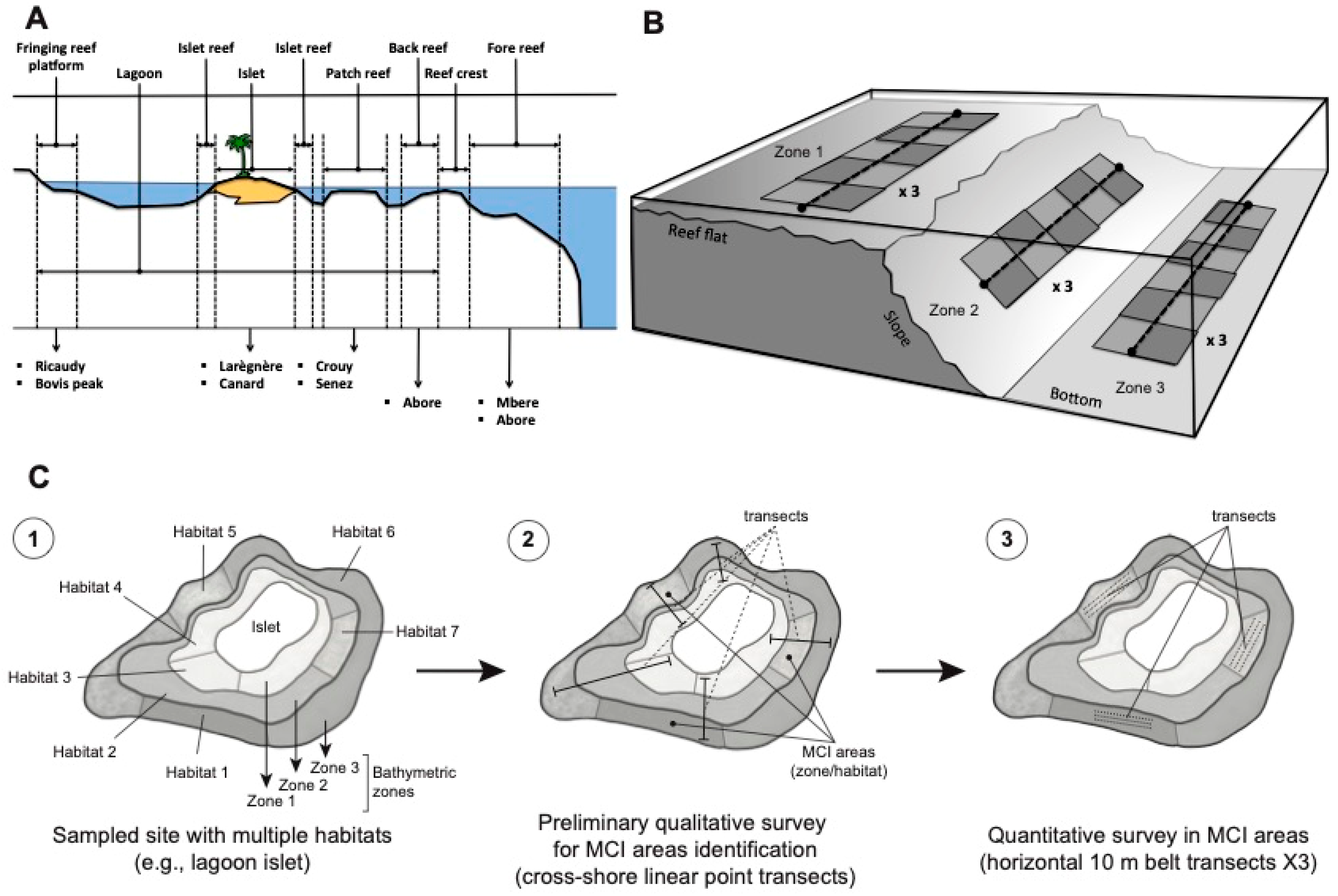
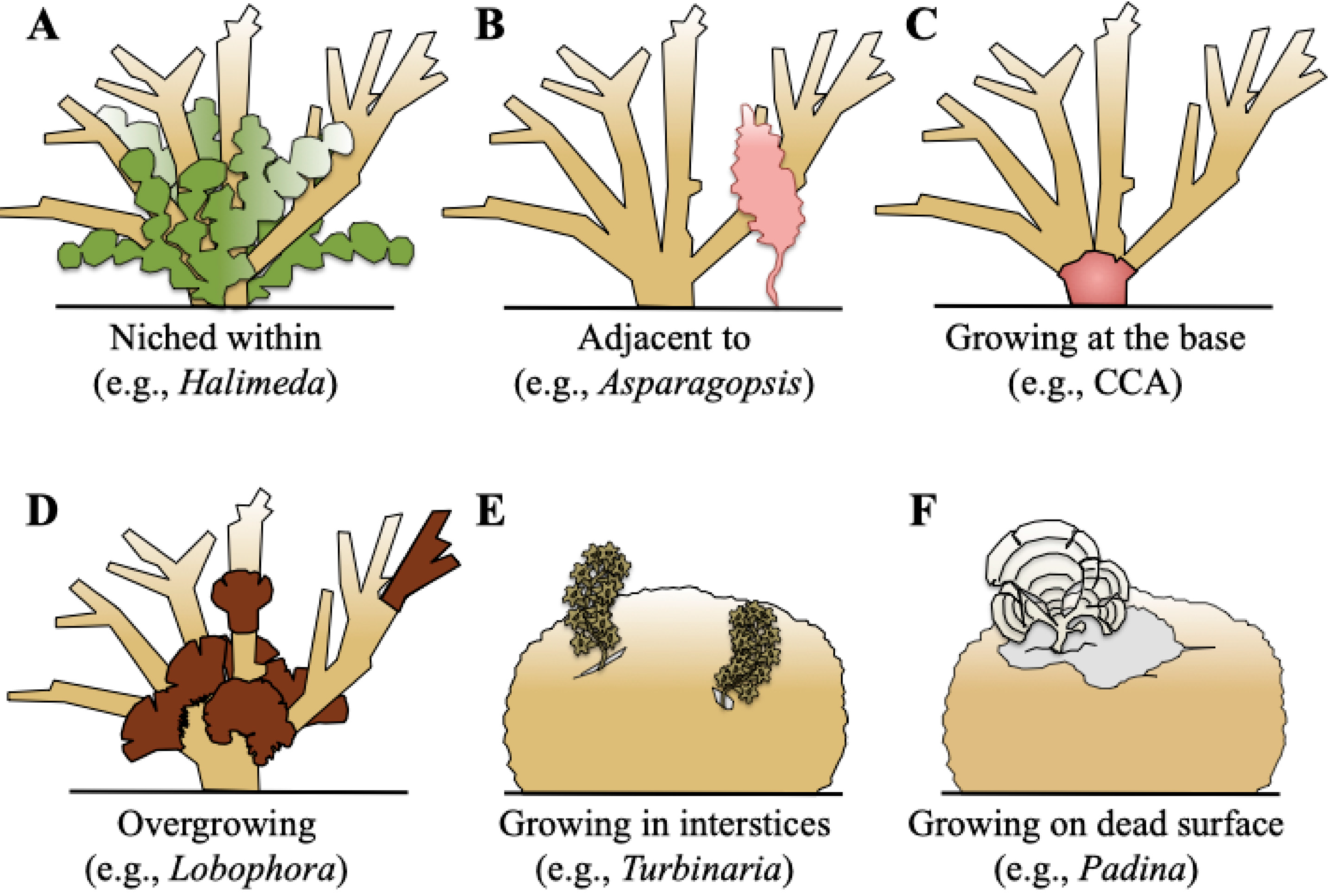
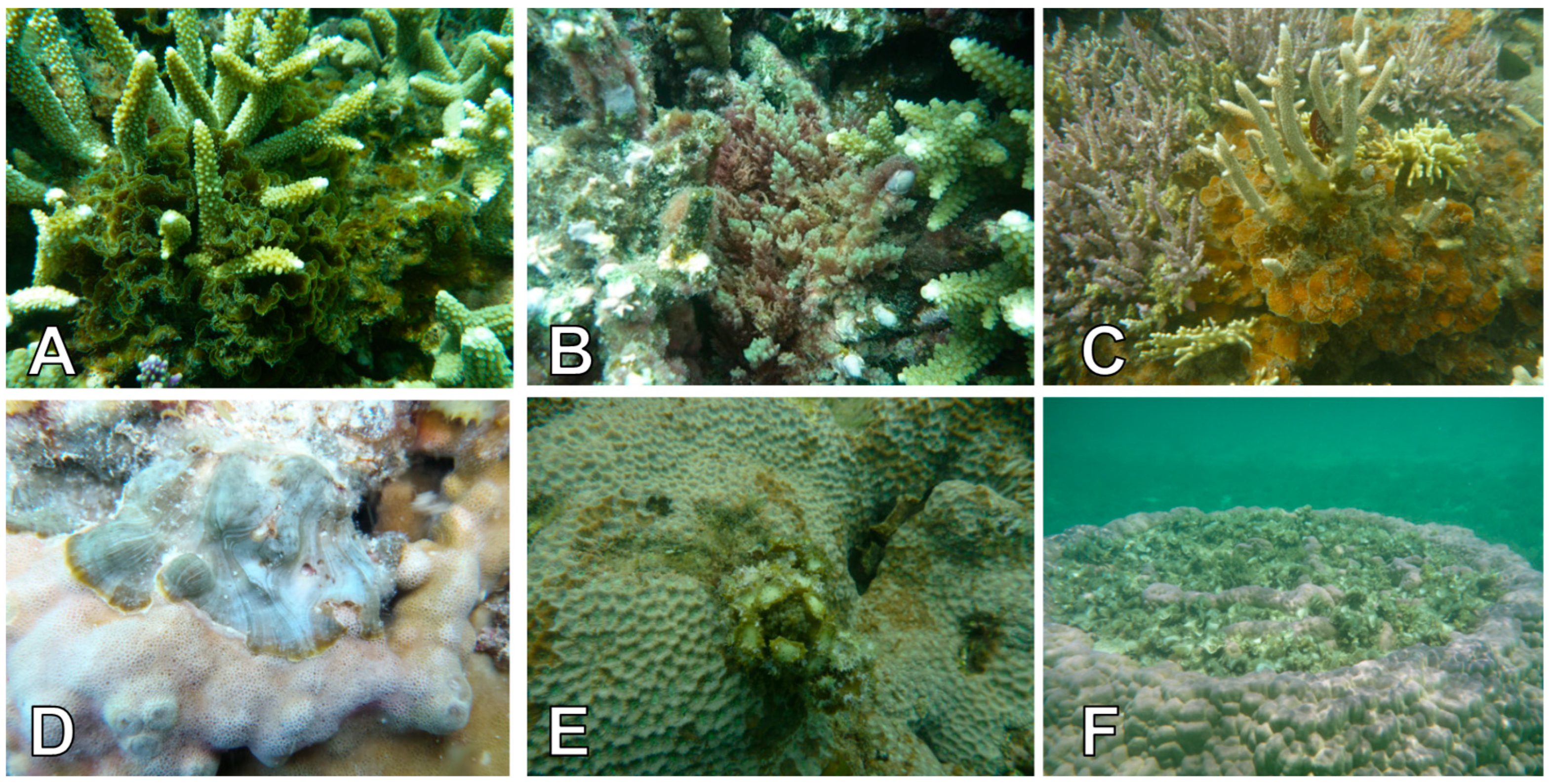
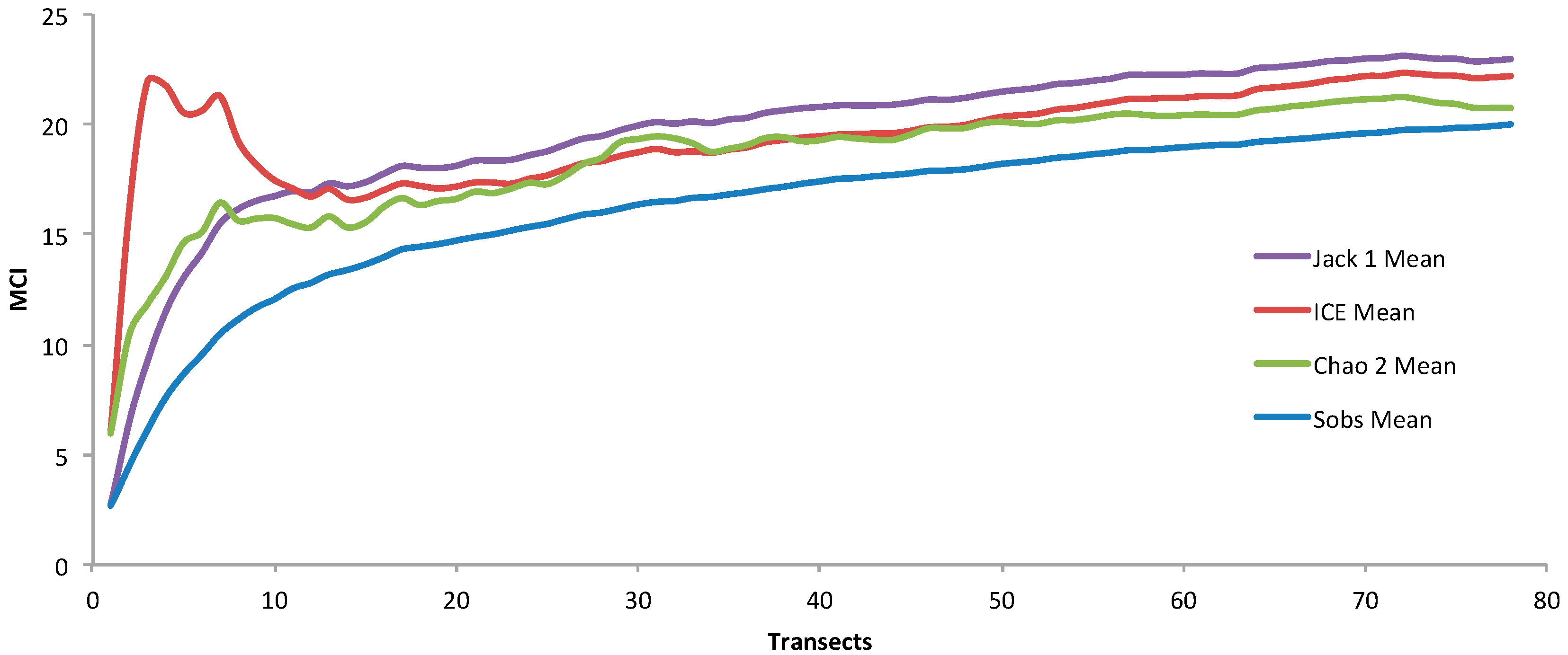
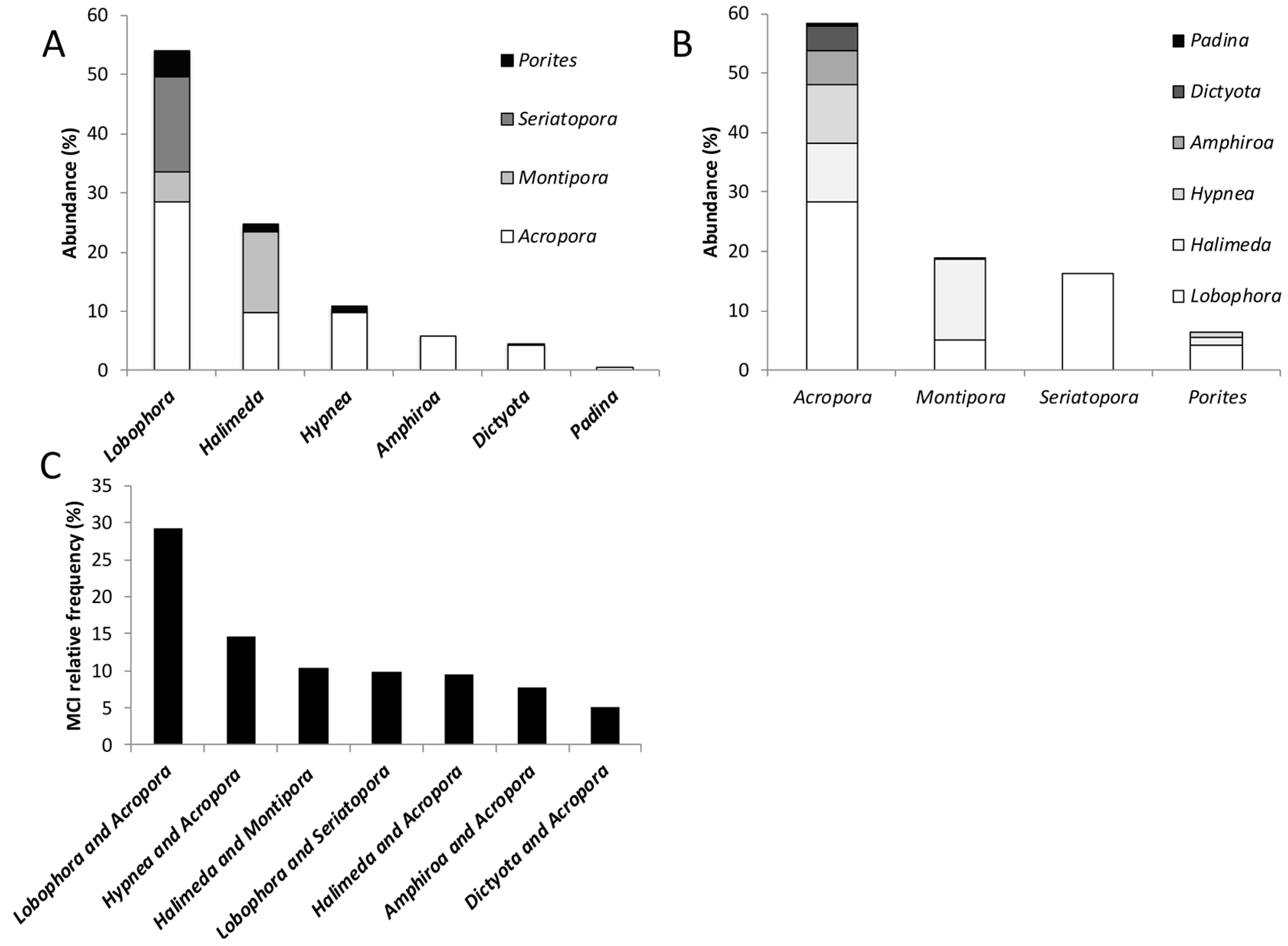
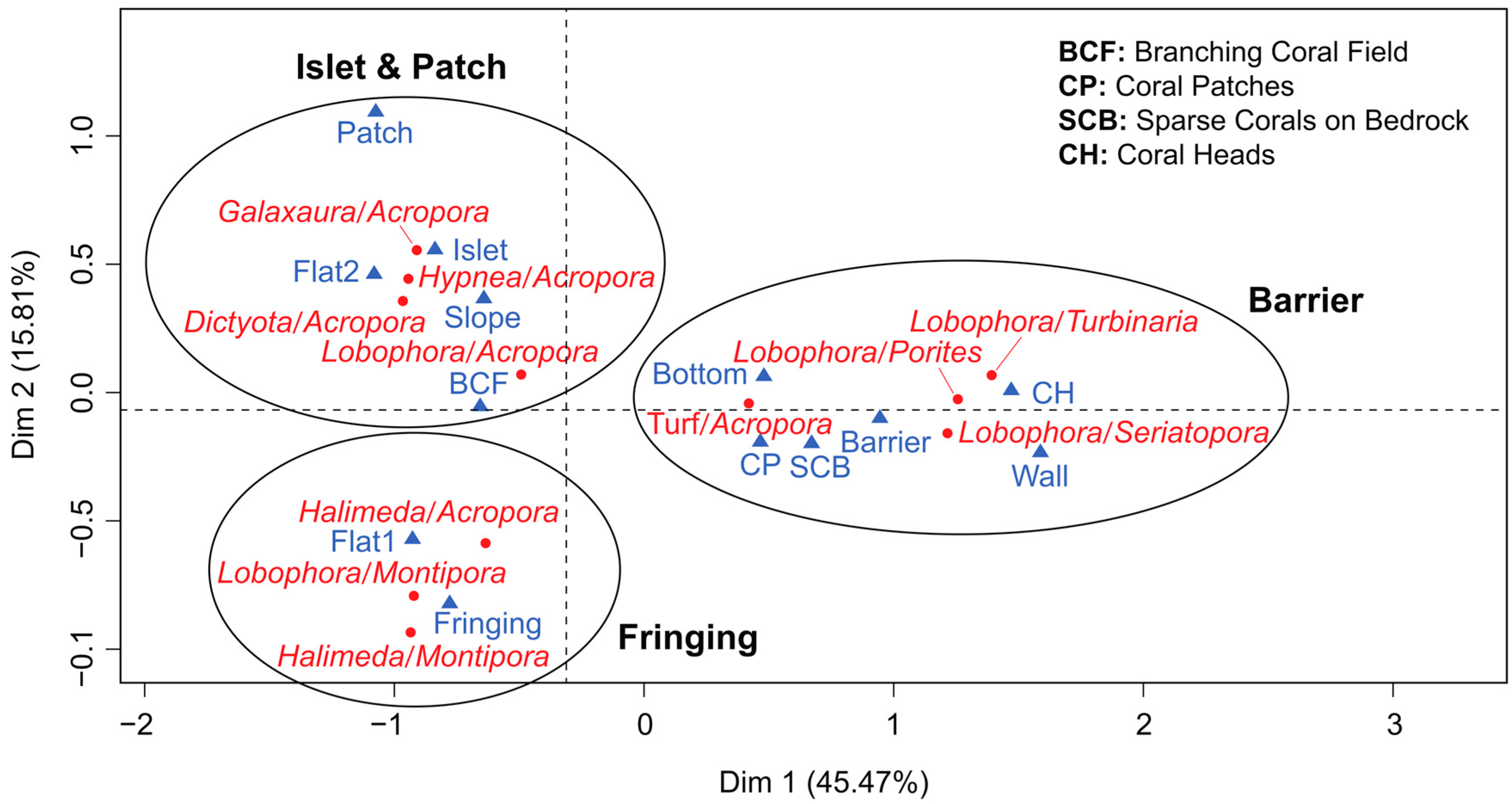
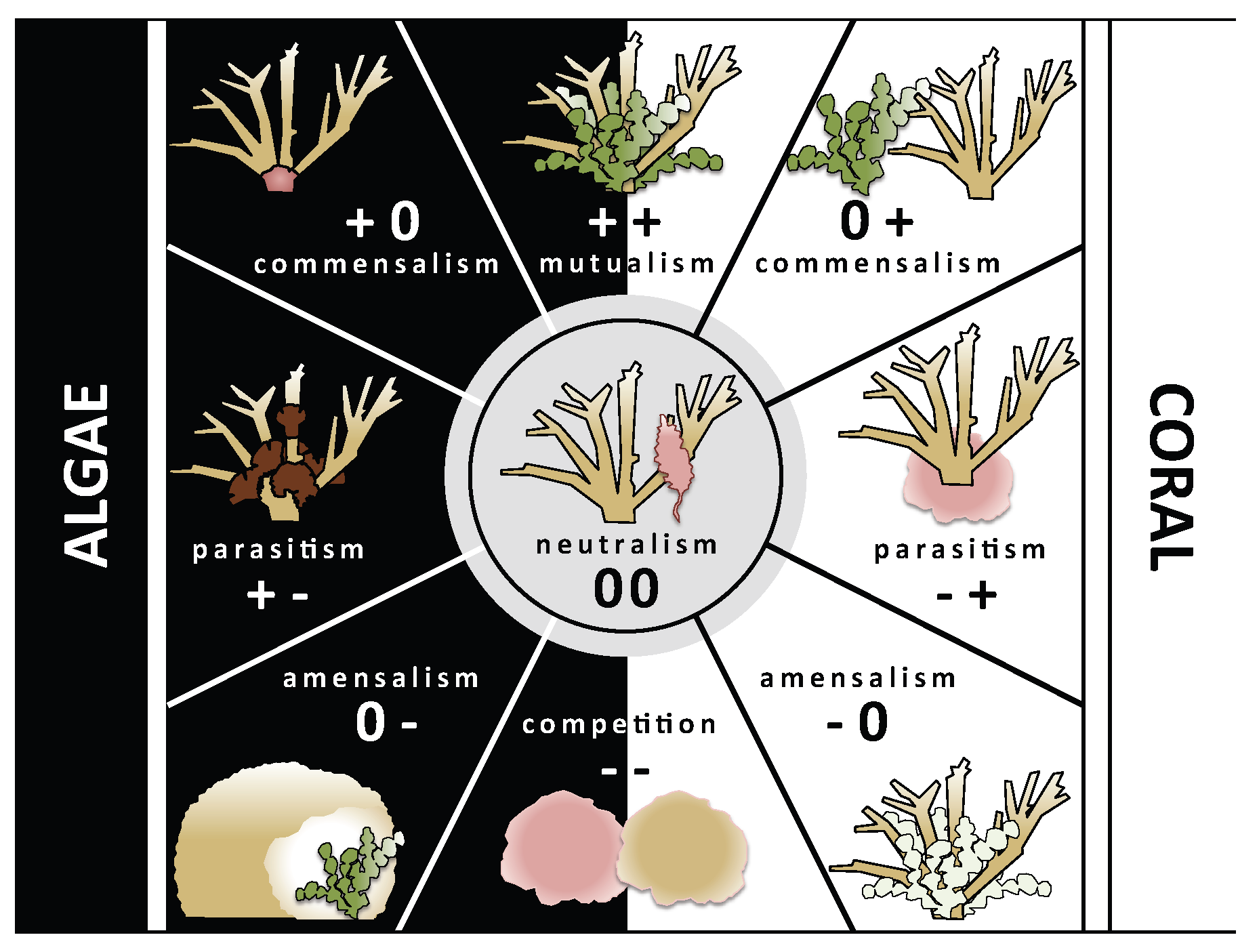
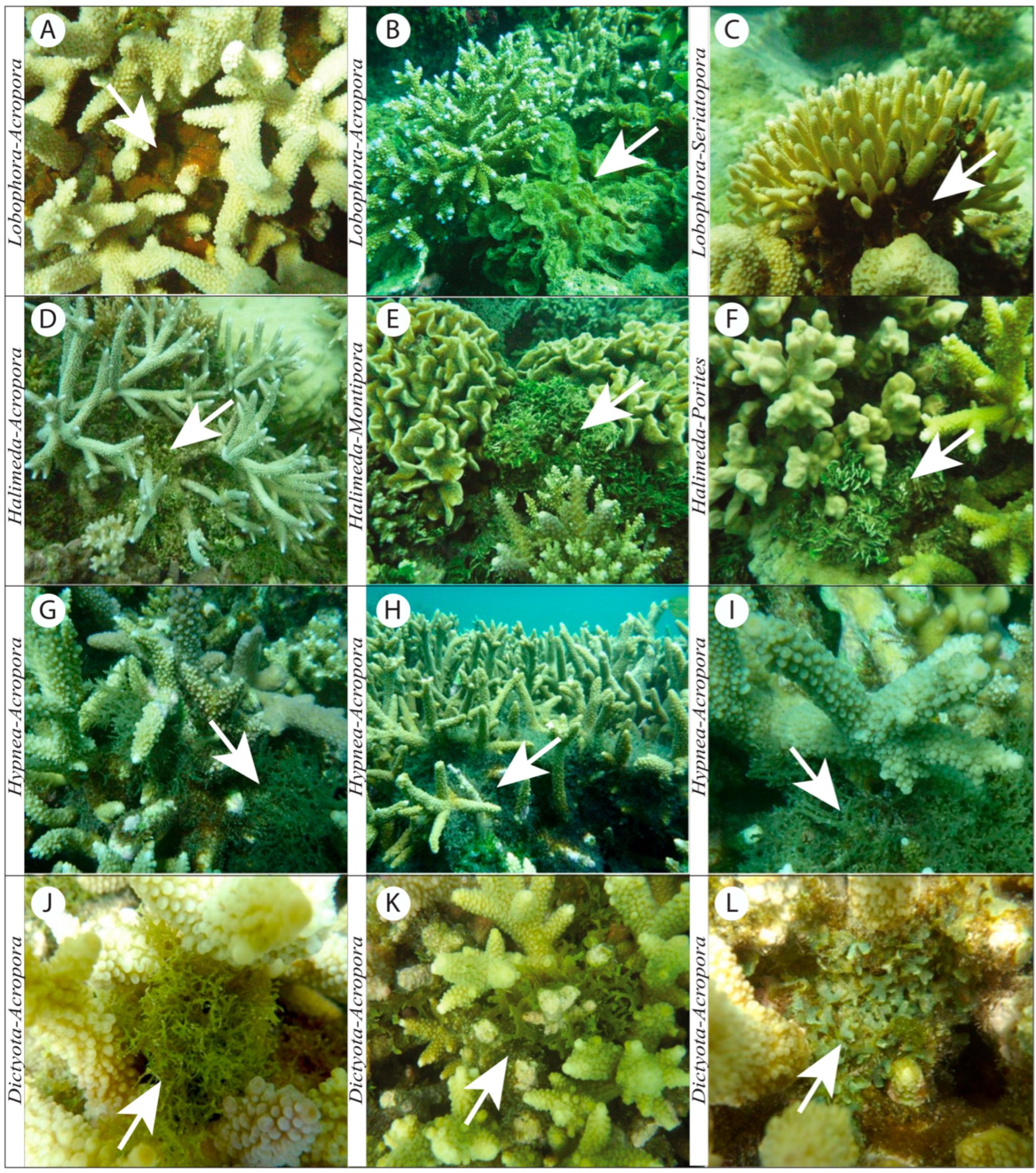
| Site # | Site Name | Reef Type | Distance to Shore (km) | Human Influence |
|---|---|---|---|---|
| 1 | Bovis | Fringing reef | 0.1 | Natural reserve |
| 2 | Ricaudy | Fringing reef | 0.1 | No restrictions |
| 3 | Canard | Islet reef | 1 | Natural reserve |
| 4 | Crouy | Patch reef | 10 | No restrictions |
| 5 | Laregnere | Islet reef | 12 | Natural reserve |
| 6 | Abore | Back reef | 18 | Integral marine reserve |
| 7 | Abore | Fore reef | 19 | Integral marine reserve |
| 8 | Mbere | Fore reef | 21 | No restrictions |
| Reef Type | Reef Zonation | Benthic Cover |
|---|---|---|
| Fringing | Flat | Branching coral field |
| Islet | Slope | Sparse corals and bedrock |
| Patch | Wall | Coral heads |
| Back reef | Bottom | Coral patches |
| Fore reef | Slope | Coral patches |
| Habitat # | Habitat Code | Location | Reef Type | Zonation | Benthos | Depth (m) | Additional Note |
|---|---|---|---|---|---|---|---|
| 1 | ABO_0001 | Abore | Patch reef | Slope | BCF | 2–5 | Patch reef |
| 2 | ABO_0002 | Abore | Patch reef | Flat | SCBR | 0–2 | Patch reef |
| 3 | ABO_0003 | Abore | Back reef | Wall | SCBR | 2–5 | Spur and groove |
| 4 | ABO_0004 | Abore | Back reef | Flat | SCBR | 0–2 | Spur |
| 5 | ABO_0005 | Abore | Back reef | Bottom | BCF | 5–10 | Groove |
| 6 | ABO_0006 | Abore | Back reef | Bottom | CH | 5–10 | Groove |
| 7 | ABOOUT | Abore | Fore reef | Slope | SCBR | 10–15 | - |
| 8 | BOV_0001 | Bovis | Fringing reef | Bottom | CH | 5–10 | - |
| 9 | BOV_0002 | Bovis | Fringing reef | Slope | BCF | 2–5 | - |
| 10 | BOV_0003 | Bovis | Fringing reef | Flat | BCF | 0–2 | - |
| 11 | BOV_0004 | Bovis | Fringing reef | Flat | SBC | 0–2 | - |
| 12 | CAN_0001 | Canard | Islet reef | Bottom | BCF | 5–10 | Windward |
| 13 | CAN_0003 | Canard | Islet reef | Slope | BCF | 2–5 | Windward |
| 14 | CAN_0004 | Canard | Islet reef | Flat | SCBR | 0–2 | Windward |
| 15 | CAN_0009 | Canard | Islet reef | Slope | BCF | 2–5 | Leeward |
| 16 | CAN_0014 | Canard | Islet reef | Flat | SPCB | 0–2 | Leeward |
| 17 | CRO_0003 | Crouy | Patch reef | Flat | BCF | 0–2 | Leeward |
| 18 | CRO_0004 | Crouy | Patch reef | Flat | BCF | 0–2 | Leeward |
| 19 | CRO_0010 | Crouy | Patch reef | Flat | BCF | 0–2 | Windward |
| 20 | RIC_0002 | Ricaudy | Fringing reef | Flat/slope | BCF | 0–2 | Windward |
| 21 | LAR_0001 | Laregnere | Islet reef | Bottom | CH | 5–10 | Leeward |
| 22 | LAR_0002 | Laregnere | Islet reef | Slope | BCF | 2–5 | Leeward |
| 23 | LAR_0003 | Laregnere | Islet reef | Flat | BCF | 0–2 | Outside islet lagoon |
| 24 | LAR_0007 | Laregnere | Islet reef | Flat | BCF | 0–2 | Inside islet lagoon |
| 25 | LAR_0010 | Laregnere | Islet reef | Flat | SCBR | 0–2 | - |
| 26 | MBEOUT | Mbere | Fore reef | Slope | SCBR | 10–15 | - |
Disclaimer/Publisher’s Note: The statements, opinions and data contained in all publications are solely those of the individual author(s) and contributor(s) and not of MDPI and/or the editor(s). MDPI and/or the editor(s) disclaim responsibility for any injury to people or property resulting from any ideas, methods, instructions or products referred to in the content. |
© 2025 by the authors. Licensee MDPI, Basel, Switzerland. This article is an open access article distributed under the terms and conditions of the Creative Commons Attribution (CC BY) license (https://creativecommons.org/licenses/by/4.0/).
Share and Cite
Vieira, C.; Peignon, C.; De Clerck, O.; Payri, C. Macroalgal–Coral Interactions in New Caledonia South West Lagoon: Diversity, Abundance, and Spatial Patterns. Biology 2025, 14, 1419. https://doi.org/10.3390/biology14101419
Vieira C, Peignon C, De Clerck O, Payri C. Macroalgal–Coral Interactions in New Caledonia South West Lagoon: Diversity, Abundance, and Spatial Patterns. Biology. 2025; 14(10):1419. https://doi.org/10.3390/biology14101419
Chicago/Turabian StyleVieira, Christophe, Christophe Peignon, Olivier De Clerck, and Claude Payri. 2025. "Macroalgal–Coral Interactions in New Caledonia South West Lagoon: Diversity, Abundance, and Spatial Patterns" Biology 14, no. 10: 1419. https://doi.org/10.3390/biology14101419
APA StyleVieira, C., Peignon, C., De Clerck, O., & Payri, C. (2025). Macroalgal–Coral Interactions in New Caledonia South West Lagoon: Diversity, Abundance, and Spatial Patterns. Biology, 14(10), 1419. https://doi.org/10.3390/biology14101419







